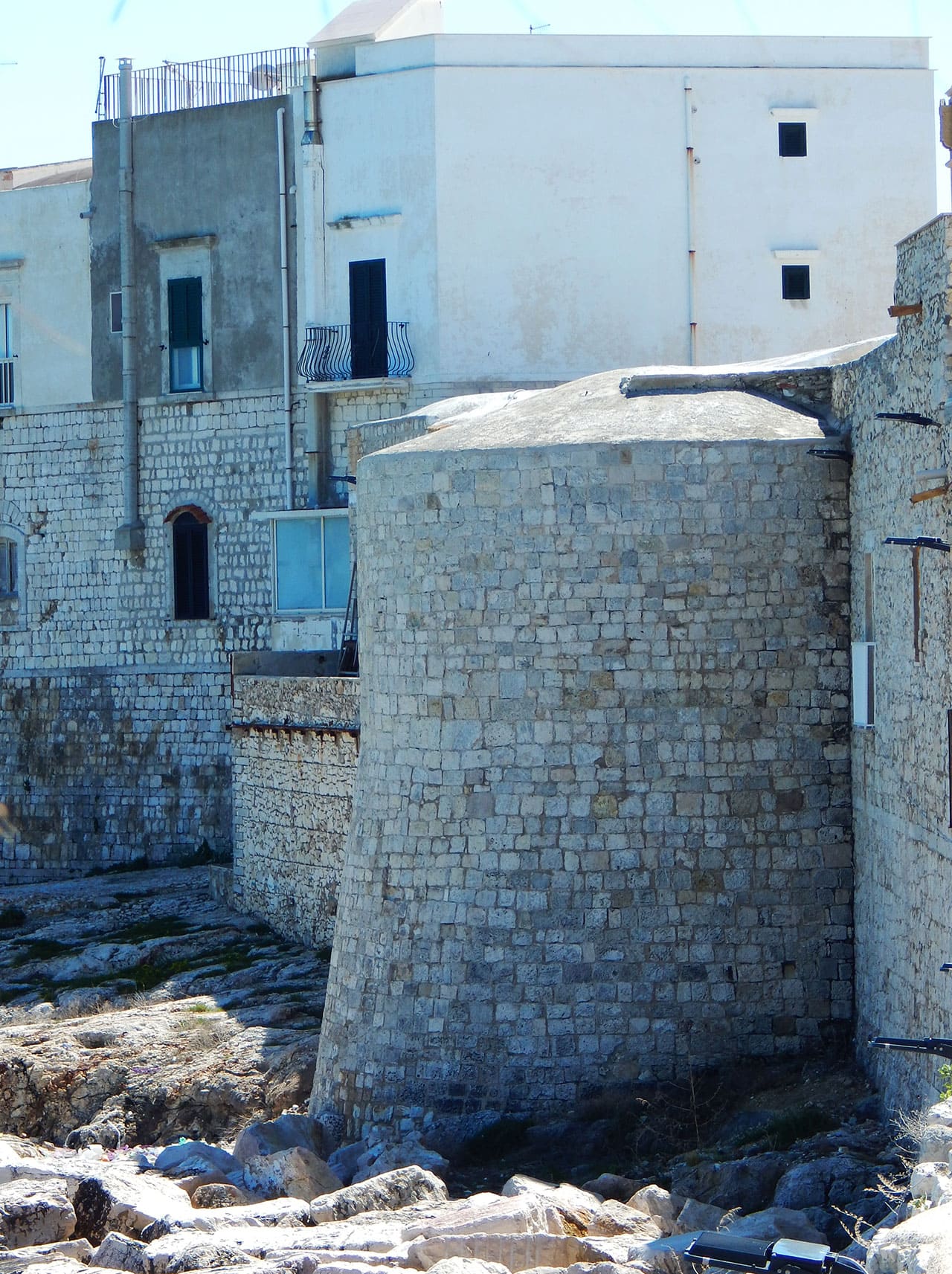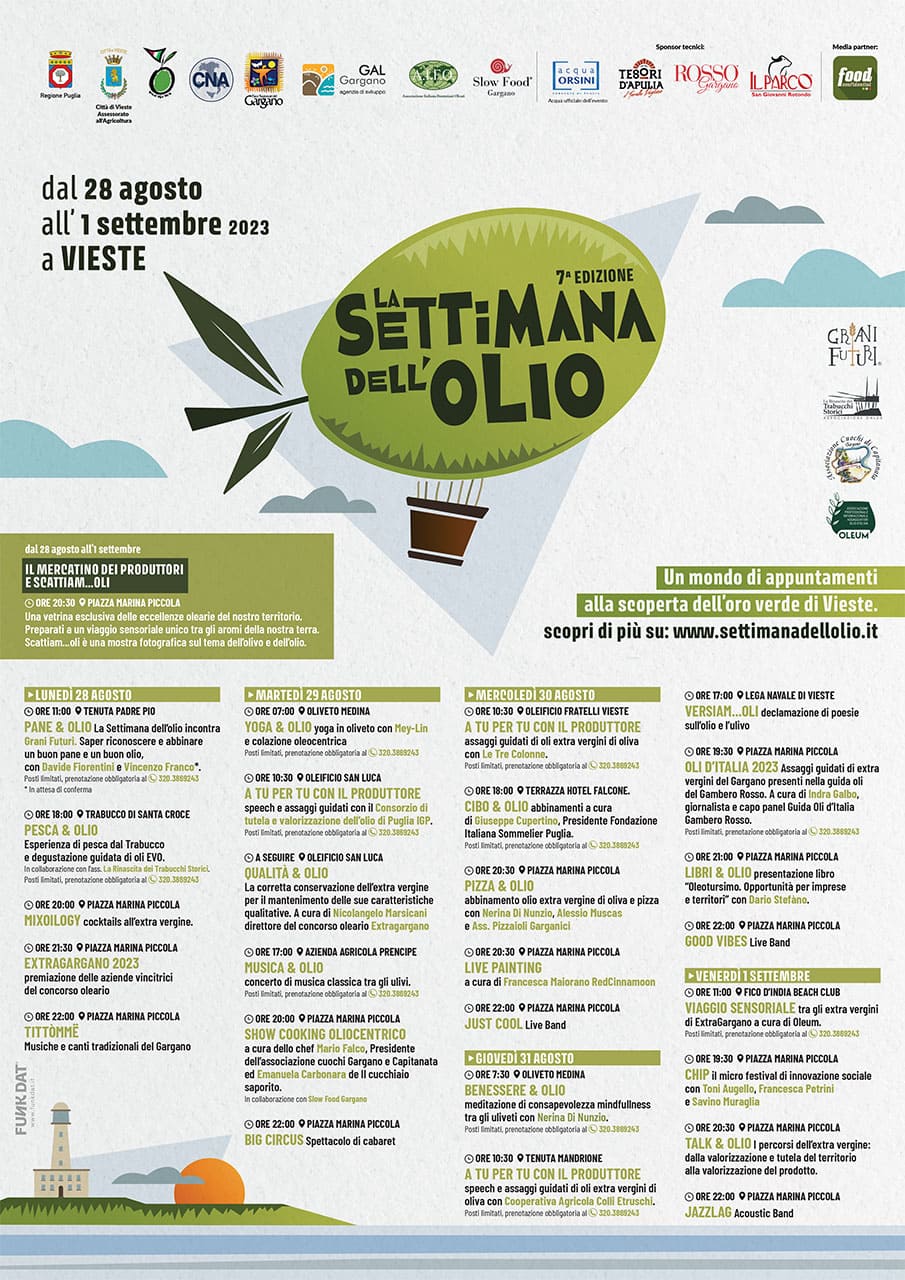I1 Barbacane è un termine militare e sta ad indicare una particolare tipologia di costruzione difensiva. Il termine di origine orientale pare che fu importato in Europa nel XII secolo e nel tempo ha assunto diversi significati. Il Barbacane di Vieste indica una specifica costruzione con mura a scarpa con la funzione di terrapieno intervallata da una struttura semicircolare posta alla distanza di 50 passi l’una. Questo tipo di costruzione serviva per dare maggiore consistenza alle mura e fungere anche da bastione di difesa. Dei dieci barbacani originari ne restano solo dei tratti e cinque sono le strutture a torre ancora esistenti: uno nei pressi del castello, uno a metà della via omonima, un altro a destra, all’imbocco di piazza del Fosso con una nicchia contenente una statua di San Michele, poi uno quadrangolare presso la Marina Piccola, e l’ultimo su via Pola. Di altri due barbacani, denominati mezzelune, si notano solo alcune tracce sempre su Via Pola e vicino il Convento di San Francesco. Per accedere alla città vi erano varie porte denominate Porta di Sopra e Porta di Basso quelle poste ai margini di Via Barbacane e la Porta della Turritta vicino al castello tutte sotto lo stretto controllo della fortezza. A queste poi si aggiungeva la Porta Falsa ricavata sulla falesia e mimetizzata ai piedi del castello usata dai cittadini per rientrare quando gli ingressi alla città erano chiusi e si poteva accedere solo se si era riconosciuti dalla sentinella che la sorvegliava.
Barbacane is a military term and indicates a particular type of defensive construction. The term of Eastern origin seems to have been imported into Europe in the 12th century and has taken on different meanings. The Barbacane of Vieste indicates a specific construction with shoe walls interspersed with a semicircular structure located at a distance of 50 steps each. This type of construction served to make stronger walls and also serve as a bastion of defense. Of the ten original barbacane there are only five sections: one tower is near the castle, the second one in the middle of the street of the same name, another on the right, at the entrance of Piazza del Fosso with a niche containing a statue of St. Michael, then a quadrangular one at the Marina Piccola, and the last on Via Pola. Two of towers, called mezzelune, there are only a few traces always on Via Pola and near the Convent of San Francesco. To access the city there were various gates called Porta di Sopra and Porta di Basso those located on the edge of Via Barbacane and the Porta della Turritta near the castle all under the strict control of the fortress. To these was added the False Door obtained on the cliff and camouflaged at the base of the castle.
MULTIMEDIALE
Nel 1239 Papa Gregorio IX ingaggia muove guerra a Federico II dopo averlo scomunicato e Venezia, sperando di aumentare il suo predominio nell’Adriatico, si schiera con il Papa. Vieste venne assalita dai Veneziani che la saccheggiarono e la bruciarono, l’Imperatore Federico II, dopo aver constatato i danni, decise di fortificare il centro abitato e di dotarlo di un castello costruendolo su un precedente presidio normanno. Nel 1535 il Vicerè di Napoli Don Pedro da Toledo, con lo sviluppo delle armi da fuoco e dei cannoni a lunga gittata, provvide ad adeguare tutte le strutture militari pugliesi per la difesa dagli assalti di nemici e di fronteggiare i sempre più frequenti attacchi piratici. A Vieste il compito fu affidato a Don Ferrante Gaitano, governatore di Capitanata e del Contado del Molise e l’esecuzione dei lavori di adeguamento alle mura urbiche furono eseguite sotto la direzione dell’architetto di corte De Simancas. I lavori, che prevedevano la realizzazione di torri intorno alle mura e presso gli ingressi, iniziarono il 21 febbraio del 1535 sotto la supervisione dei capomastri Colantonio e Santillo e l’amministrazione dei notai viestani Costantino e De Carluciis che, all’atto della redazione del contratto, misero una clausola in cui si richiedeva l’impiego di lavoratori viestani. Molte persone allora furono impiegate per il legname, il materiale edile e la malta ingaggiando tutti i fornaciai del paese. L’opera fu completata il 13 Aprile del 1543 dal Vicerè Don Perafan de la Ribera che utilizzò presto il castello di Vieste per condurre le guerre navali che si svolgevano in Adriatico tra Francia e Spagna. Le mura urbiche subirono successivamente altri interventi per essere completamente abbandonati dopo l’Unità d’Italia. Una parte dei barbacani allora si trasformarono in botteghe e magazzini, in alcuni tratti crollarono. e in altri furono occupati per la realizzazione di nuove case.
In 1239 Pope Gregory IX waged war on Frederick II after excommunicated him and Venice, hoping to increase his dominance in the Adriatic, sided with the Pope. Vieste was attacked by the Venetians who sacked and burned it, so the Emperor Frederick II, after noticing the damage, decided to fortify the town and equip it with a castle on a previous Norman miltary tower. In 1535 the Viceroy of Naples Don Pedro da Toledo, with the development of firearms and long-range cannons, proceeded to adapt all the apulian military structures for the defense against assaults of enemies and to face the increasingly frequent pirate attacks. Vieste was entrusted with the task of Don Ferrante Gaitano, governor of Capitanata and Contado del Molise, and the execution of the adaptation works to the urbic walls was carried out under the direction of the court architect De Simancas. The works, which provided for the construction of towers around the walls and at the entrances, began on February 21 1535 under the supervision of the master builders Colantonio and Santillo and the administration of the Viestan notaries Costantino and De Carluciis who, at the time of writing the contract, put a clause requiring the employment of local workers. Many people were then employed for timber, building materials and mortar, having handled all the bakers in the country. The work was completed on April 13, 1543 by Viceroy Don Perafan de la Ribera who soon used the castle of Vieste to conduct the naval wars in the Adriatic Sea between France and Spain. The Urban walls later uneaded other interventions to be completely abandoned during the Reign of Italy. Some of the barbacani then turned into shops and warehouses, in some places they collapsed. and in others they were occupied for the construction of new houses.
1239 erklärte Papst Gregor XI. nach der Exkommunikation Friedrich II. den Krieg. Venedig stellte sich auf die Seite des Papstes. Kaiser Friedrich II. beschloss, die Stadt zu befestigen und auf der alten normannischen Festung eine Burg zu errichten, nachdem Venezia die Stadt Vieste geplündert und niedergebrannt hatte. 1535 befestigte der Vizekönig von Neapel, Don Pedro von Toledo, aufgrund der Waffenentwicklung und der Langstrecken-Kanonen alle militärischen Einrichtungen zur Verteidigung vor Angriffen von Feinden und Piraten. Don Ferrante Gaetano, Gouverneur von Gargano und Molise, hatte diese Aufgabe in Vieste, und die Durchführung der Anpassungen der Stadtmauern wurde vom Architekten De Simancas geleitet. Die Bauarbeiten begannen am 21. Februar 1535 und umfassten den Bau von Türmen um die Mauern und am Eingang. Viele Einwohner waren beteiligt, da im Vertrag die Einstellung von Mitarbeitern aus Vieste gefordert wurde. Der Vizekönig Don Perafan schloss den Bau ab und nutzte die Burg für die Seeschlachten an der Adria zwischen Frankreich und Spanien. Die Stadtmauern wurden nach der Vereinigung Italiens stillgelegt. Einige Türme wurden zu Läden und Lagerräumen, einige stürzten ein und einige wurden zu Häusern.















